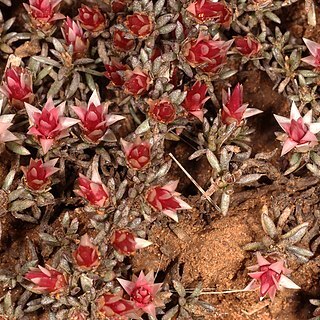Mat-forming subshrub, stock woody, up to 10 mm diam., main branches up to 300 mm long, many, prostrate, radiating from the crown, branching and giving rise to numerous very short (up to 5 mm) erect flowering branchlets, very closely felted, densely leafy, the whole forming a flowery mat. Leaves 3-8 x 0.5(-1.75) mm, not diminishing in size upwards, imbricate, linear, acute, base broad, half-clasping, margins generally revolute, both surfaces closely enveloped in closely woven, silky grey tissue-paper-like indumentum, glandular as well, rarely woolly. Heads heterogamous, narrowly campanulate, ±6 x 4 mm, sessile, solitary at the tips of the branchlets, these racemosely arranged. Involucral bracts in ±6 series, graded, loosely imbricate, inner exceeding flowers, all radiating, semi-pellucid, glossy, outer white, inner rose-red, tips more or less opaque, subacute, mostly white. Receptacle shortly honeycombed. Flowers 19-31, 3-10 female, 12-25 homogamous, yellow, tipped pink. Achenes not seen, ovaries with myxogenic duplex hairs. Pappus bristles many, equalling corolla, scabridulous, bases cohering strongly by patent cilia. Flowering between June and November, mainly August and September.
More
Subshrub, mat-forming, procumbent, stems up to 300 mm long, closely felted, densely leafy; flowering stems very short, up to 5 mm high. Leaves imbricate, blade linear, 3-8 x 0.50(-1.75) mm, apex acute, base broad, half-clasping, margins revolute, both surfaces silky grey-hairy, glandular. Heads disciform, campanulate, ± 6 x 4 mm, sessile, solitary at tips of short, erect branchlets, these racemosely arranged. Involucral bracts in ± 6 series, graded, loosely imbricate, inner exceeding florets, radiating, glossy, outer white, inner rose-red, tips white, subacute, stereome divided. Receptacle epaleate, shortly honeycombed. Flowers: female and disc florets 19-31, 3-10 female; corolla of disc florets funnel-shaped, yellow, tipped pink; Aug.-Nov. Fruit with cypsela? (and ovary) hairy. Pappus of many barbellate bristles, bases cohering strongly by patent cilia.

